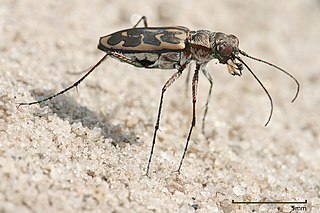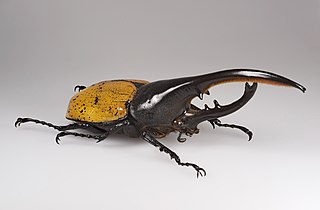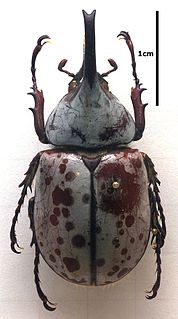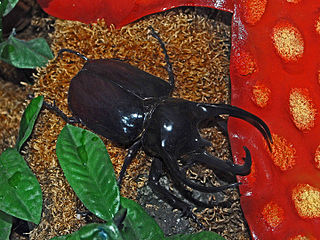
Beetles are a group of insects that form the order Coleoptera, in the superorder Endopterygota. Their front pair of wings are hardened into wing-cases, elytra, distinguishing them from most other insects. The Coleoptera, with about 400,000 species, is the largest of all orders, constituting almost 40% of described insects and 25% of all known animal life-forms; new species are discovered frequently. The largest of all families, the Curculionidae (weevils), with some 83,000 member species, belongs to this order. Found in almost every habitat except the sea and the polar regions, they interact with their ecosystems in several ways: beetles often feed on plants and fungi, break down animal and plant debris, and eat other invertebrates. Some species are serious agricultural pests, such as the Colorado potato beetle, while others such as Coccinellidae eat aphids, scale insects, thrips, and other plant-sucking insects that damage crops.

The family Scarabaeidae, as currently defined, consists of over 30,000 species of beetles worldwide; they are often called scarabs or scarab beetles. The classification of this family has undergone significant change in recent years. Several subfamilies have been elevated to family rank, and some reduced to lower ranks. The subfamilies listed in this article are in accordance with those in Bouchard (2011).

Tiger beetles are a large group of beetles, from the Cicindelinae subfamily, known for their aggressive predatory habits and running speed. The fastest known species of tiger beetle, Cicindela hudsoni, can run at a speed of 9 km/h, or about 125 body lengths per second. As of 2005, about 2,600 species and subspecies were known, with the richest diversity in the Oriental (Indo-Malayan) region, followed by the Neotropics.

The longhorn beetles (Cerambycidae), also known as long-horned or longicorns, are a large family of beetles, with over 26,000 species described, slightly more than half from the Eastern Hemisphere. Most species are characterized by extremely long antennae, which are often as long as or longer than the beetle's body. In various members of the family, however, the antennae are quite short and such species can be difficult to distinguish from related beetle families such as the Chrysomelidae. The scientific name of this beetle family goes back to a figure from Greek mythology: after an argument with nymphs, the shepherd Cerambus was transformed into a large beetle with horns.

A horn is a permanent pointed projection on the head of various animals that consists of a covering of keratin and other proteins surrounding a core of live bone. Horns are distinct from antlers, which are not permanent. In mammals, true horns are found mainly among the ruminant artiodactyls, in the families Antilocapridae (pronghorn) and Bovidae. Cattle horns arise from subcutaneous connective tissue and later fuse to the underlying frontal bone.

The Hercules beetle is a species of rhinoceros beetle native to the rainforests of Central America, South America, and the Lesser Antilles. It is the longest extant species of beetle in the world, and is also one of the largest flying insects in the world.

Dynastinae or rhinoceros beetles are a subfamily of the scarab beetle family (Scarabaeidae). Other common names – some for particular groups of rhinoceros beetles – include Hercules beetles, unicorn beetles or horn beetles. Over 1500 species and 225 genera of rhinoceros beetles are known.

Dynastes tityus, the eastern Hercules beetle, is a species of rhinoceros beetle that lives in the Eastern United States. The adult's elytra are green, gray or tan, with black markings, and the whole animal, including the male's horns, may reach 60 mm (2.4 in) in length. The grubs feed on decaying wood from various trees.

The flea beetle is a small, jumping beetle of the leaf beetle family (Chrysomelidae), that makes up the tribe Alticini which is part of the subfamily Galerucinae. Historically the flea beetles were classified as their own subfamily.

The Japanese rhinoceros beetle, Japanese horned beetle, or kabutomushi (カブトムシ), Allomyrina dichotoma, is a species of rhinoceros beetle.

Cleridae are a family of beetles of the superfamily Cleroidea. They are commonly known as checkered beetles. The family Cleridae has a worldwide distribution, and a variety of habitats and feeding preferences.

Strategus aloeus, the ox beetle, is a species of rhinoceros beetle. The "major" males of this species have three large horns on their thoraces, resembling the Triceratops. The "minor" males have horns, as well, but the two back ones are small and the frontal horn is much shorter than the horn in major males. The female ox beetle has a very short horn which has little use in fighting, but is used for digging in the ground. These beetles grow to about 1.0 to 1.5 in long as adults when the horns are excluded in the males.

Dynastes is a genus of large beetles belonging to the family Scarabaeidae. They occur in the Nearctic realm and in the Neotropical realm, from the United States to Brazil; four North American species, three with distributions extending from Central America either north or south, and two species endemic to South America.

Actaeon beetle is a rhinoceros beetle of the family Scarabaeidae.

Acanthoscelides is a genus of bean weevils of the subfamily Bruchinae. They are native to the New World. About one third of them can be found in Mexico.

The Moellenkampi beetle, aka three-horned rhinoceros beetle, is one of three large species of dynastid rhinoceros beetles from Southeast Asia belonging to the genus Chalcosoma. The Moellenkampi beetles belong to the beetle family Scarabaeidae along with other rhinoceros beetles. They are characterized by having two large, forward-projecting horns on the pronotum or thorax, and another large, forward and upward-projecting horn on the head. They also have a distinct metallic lustre, which is the reason behind their genus name, which derives from Greek, chalko-, and is the combining form of chalkós, meaning copper.

Zographus oculator, the Orange-eyed Long-horn Beetle, is a species of flat-faced longhorn beetles belonging to the family Cerambycidae.

Chalcosoma caucasus is a species of beetle in the family Scarabaeidae. This species can be found from Malaysia south into Indonesia and Thailand in East region.

Glenea theodosia is a species of beetle in the family Cerambycidae. It was described by James Thomson in 1879. It is known from the Philippines and Malaysia.



















